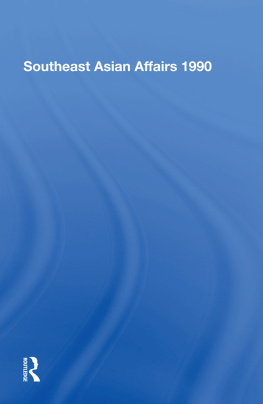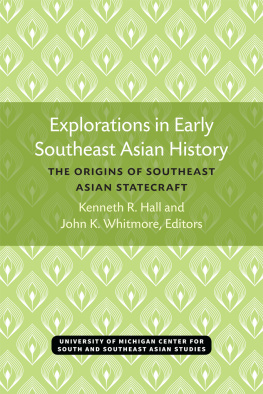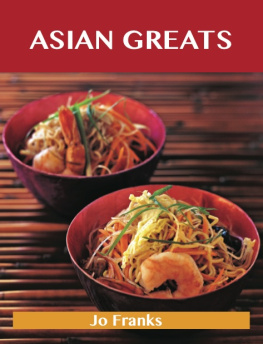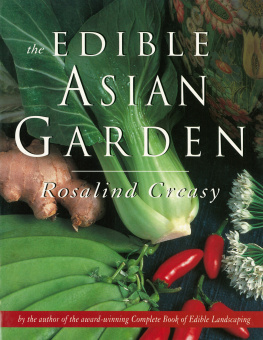Essential Strategies for Eating Out at Japanese, Chinese, Southeast Asian, Korean, and Indian Restaurants
Steven A. Shaw
T he many restaurateurs, chefs, and other industry folks who made this book possible are not listed in these acknowledgments, but are, rather, named throughout this volume. In addition, Id like to thank:
The many participants in the eG Forums online discussions at www.eGullet.org who offered invaluable advice, assistance, contacts, and moral support from the earliest stages of the project through its conclusion.
Those who wrote books, articles, and online resources that made my job easier. In particular: Joel Denker, author of World on a Plate, a superb ethnic food history (Dr. Denker also answered all my e-mails and phone calls and sent me many helpful references); Trevor Corson, author of The Zen of Fish, and Sasha Issenberg, author of The Sushi Economy, two great books on sushi; Eve Zibart, author of The Ethnic Food Lovers Companion, a handy reference I always kept near me while I wrote; Jeffrey Steingarten and Alex Renton for their articles, in Vogue and the Guardian, respectively, on MSG, Chinese food, and health; Lynne Olver, creator of The Food Timeline (www.foodtimeline.org); and all the people who have contributed Asian-food information to Wikipedia.
Author Michael Ruhlman for introducing me to Annie Chiu; Connie Nelson of the Wilmington/Cape Fear Coast Convention & Visitors Bureau for introducing me to Solange Thompson; Gita Sweeney of the Gita Group for introducing me to Ratha Chau; Karen Schloss and Frank Diaz of Diaz*Schloss Communications for introducing me to the Mehtani family; and chef Brian Bistrong for introducing me to Jenny Kwak (and Ms. Kwak for introducing me to her father, a font of wisdom on Korean-American history).
My editor, Gail Winston, her associate, Sarah Whitman-Salkin, and copyeditor, Katherine Ness, for turning my manuscript into a book. Also my previous editors at HarperCollins, Susan Friedland and Harriet Bell, for getting me this far.
My unofficial editorial team: my wife, Ellen Shapiro, my friend and colleague Dave Scantland, and my agent, Michael Psaltis, for pushing me to do my best.
Wayne and Julie Shovelin for letting me use their beach house as a writers retreat. My mother, Penny Shaw, for all the babysitting and countless other forms of assistance. And my wife, Ellen, our son, PJ, and our bulldog, Momo, for filling our home with love.
I n 1981, when I was twelve years old, a restaurant called Empire Szechuan Columbus opened across the street from our apartment on Manhattans Upper West Side. It changed the course of my diet forever. This was Chinese food like Id never before tasted: fresh, vibrant, spicy. My father, whose friend the U.S. table tennis champion (and hustler) Marty Reisman was an investor in the restaurant, and I spent years working our way through just about every dish on the exhaustive menu.
We even invented some dishes of our own, especially after my father had a heart attack and was placed on a low-fat, low-salt diet by his cardiologist and a lower-fat, lower-salt diet by my mother. In those days, low-sodium soy sauce was a niche product that you couldnt just pick up at the supermarket. My father would buy a bottle of it in Chinatown about once a year, and the Empire Szechuan kitchen would store it for use in his dishes. Lobster Cantonese was prepared for him with egg whites only, no pork. Another dish, which we named Chicken with Red Spots, used hot chilies to liven up otherwise bland chicken with snow peas.
Outside the view of my parents, I continued to sample dishes from the less virtuous end of the spectrum. Though Im Jewish and from New York City, Im sure I ate more Chinese pork dumplings in the 1980s than any Chinese personor perhaps any villagein China. I ate so many pork spare ribs that even today, pigs shudder when I approach.
What I ate the most of, however, was the Empire Szechuan egg roll, the finest specimen Id ever tasted. Most days, on the way home from school after I got off the number 10 bus, Id stop by and, with the carefully collected loose change in my pocket, buy an egg roll. Mary, the co-owner (and wife of the chef ), who took all the orders from behind the take-out counter/hostess station, knew not to put my egg roll in a paper bag. She handed it to me, half-wrapped in a wax-paper sleeve, with a little plastic packet each of soy sauce and duck sauce. Id bite off the top of the steaming egg roll, pour both sauces onto the exposed innards, and gleefully chomp the egg roll on my walk home. Id have it finished by the time I crossed the street and rode the elevator up to our apartment.
If Mary was the heart of the institution, and her husband the chef its soul, the brain of Empire Szechuan Columbus was surely Mr. Chu. A former professor of mathematics from Taiwan, Mr. Chu was in charge of coordinating the restaurants urban-planning-scale take-out and delivery operation. Mr. Chu had the preternatural ability not only to plan each deliverymans route so as to maximize profit by minimizing time, efficiently sequencing multiple drop-offs per trip, but also to make unfailingly accurate predictions of future orders and the resources needed to accommodate them. Graph theory, the branch of mathematics used to evaluate complex networks, was Mr. Chus specialty.
One night my father and I walked in on family meal (in the restaurant business, thats what they call the staff dinner), and Mr. Chu beckoned us over. He held up a plate of thin, curved strips of gelatinous somethingmaybe flesh, maybe a vegetableor perhaps a dessert? It tasted like sweet, squishy bacon.
You like? asked Mr. Chu.
What is it? asked my father.
Pig ear! exclaimed Mr. Chu.
For the rest of my fathers life, we could always get a laugh out of each other by injecting the phrase pig ear! (pronounced pig eah) randomly into a conversation.
We became part of the restaurants family. By the time I went to college, my farewell dinner was like a send-off of one of Mr. Chus own children. He inquired after me while I was away and always had a smile and a math anecdote for me when I came home over breaks. He surely knew more about my love life than my own family, since I took every girlfriend I ever had (all two of them) to Empire Szechuan repeatedly.
At my engagement party, held in the upstairs room of the restaurant, we needed to limit the head count to the rooms capacity, so we invited friends onlyno parents. Mr. Chu delegated the take-out operation to Mary for the night and observed the event, all the while furiously scribbling notes in Chinese on a waiters order pad.
Later that night, I caught my father and Mr. Chu huddled at a table by the window. Mr. Chu had transcribed and translated into Chinese every speech given at the engagement party and was, on the fly, translating them back into English in order to relay them to my father. And then, best man says That was also the night that Mary, for the first time in my life, came out from behind the hostess station. She was only about four and a half feet tall! All those years, unbeknownst to me, she had been sitting on a stool, making her look much taller.
Empire Szechuan is still there, though today its called Empire Szechuan Kyoto thanks to the addition of, as is now common at Chinese restaurants, a sushi bar. Mary is still there too, as is her husband the chef, though their American-born children have no interest in the restaurant business. Mr. Chu departed long ago to open his own restaurant. My mother still lives across the street, and now my wife and I bring our two-year-old son in for dinner. They spoil him rotten. It drives my wife crazy. I dont mind.










